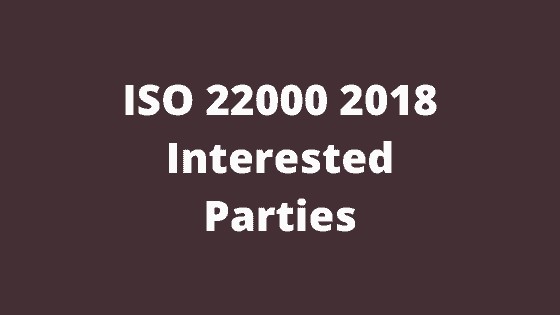ISO 22000 2018 INTERESTED PARTIES
ISO 22000 2018 Interested Parties – Over the years, the ISO 22000 has been changed and no longer been focused on the customer, the consumer has been replaced with the term ‘interested party’. In this section, we will discuss who are those Interested Parties in the ISO 22000 2018, and how we can understand their needs and expectations.
all the interested parties often can be referred to as “stakeholders”, that can have either a negative or positive influence on the FSMS. Before addressing the expectations and needs of any interested party, the relevance and significance of the interested parties are first decided upon.
The interested party can be anybody: regulators, customers, employees, landlords, consumers, distributors, trade suppliers, shareholders, etc.
Identifying and analyzing the interested parties is essential in helping to know how they could affect the realization of the main goals of the FSMS that s intended to ensure food safety. Some of the interested parties’ expectations and needs are mandatory; hence, they are enshrined into the regulatory requirements and laws.
For that reason, they must be considered at all costs. All the identifiable interested parties and their expectations and needs must be reviewed once they’ve been defined and after the organization has applied some changes.
Once you’ve defined your interested parties and known their identities, ISO 22000 2018 version requires you to determine both their potential and actual effects:
For instance:
1. Customers/End Users
- Expectations and needs of Customers/End Users :
- Buying quality food products prepared in hygienic conditions in the absence of all health hazards
2. Legislative and Regulatory Bodies (can be international, national, provincial/regional or local)
- Expectations and needs of Legislative and Regulatory Bodies
- Collective health of the people and their longevity – which are part of the country’s sustainable development plan – as well as compliance with international standards, regulations, and national laws
3. Employees
Expectations and needs of Employees
- The organization is expected to provide a healthy, hygienic, and safe working environment that poses no occupational infections or injuries. The organization is also expected to foster professional development and growth through benefits, rewards, and training.
4. Community
Expectations and needs of the Community
The organization is expected to improve human health, minimize the risk of poisoning and contribute to the local population and environment
5. Owners
Expectations and needs of Owners
Owners expect stable dividends/profits, reliable and long term cooperation, and minimal risk of supply chain disruptions. They also expect legal and financial compliance as well as avoiding fines and penalties while recording excellent performance.
6. External Providers
Expectations and needs of External Providers
They expect continuous orders and prompt payments and long working relationship
7. Certification bodies
Expectations and needs of Certification bodies
Certification bodies expect the organization to implement effective Food Safety standards as required.
The scope of the FSMS – How to determine it
The scope of the FSMS isn’t entirely new but has been updated to describe the geographical site or physical location in which your organization operates, the services and/or products defined in the FSMS, all the interested parties and the special characteristics such as shelf-life conditions and storage.
The statement of the scope must be kept as documented information. You must declare the scope in the statement if the application of the NQA is required to undergo system auditing for certification. This is to enable them to send the right and experienced auditor.
For instance:
The fermentation, baking, packaging of bread into crates
The example above entails several steps that entail the use of machinery, external providers, workers, customers, regulatory requirements, etc.
ISO 22000 2018 Interested Parties – Food safety management system
Pursuance of previous clauses, organizations, therefore, have to create, implement and maintain and improve an FSMS system. This section recognizes the value of emphasizing the interaction of processes.
For now, QSE Academy suggests reading other materials produced on our website. You could also check out our packages for instructions and tips.
Looking for More Resources on ISO 22000?
If you found this article helpful, explore our premium resources designed to help you achieve ISO 22000 certification efficiently:
- 📦 Complete Documentation Package for ISO/IEC 22000 2018: Get all the essential templates and documents you need for fast, easy implementation.
- 🎓 Online Course on ISO/IEC 22000 2018 : Enroll in our comprehensive training to master the key concepts and practical steps toward certification.
- 📋 ISO/IEC 22000 2018 Checklist: Download our detailed checklist to ensure you’ve covered every step of the process.
These resources are tailored to meet your needs and ensure a smooth certification journey. Explore them today and get one step closer to success!






















